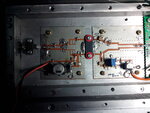adnan012
Advanced Member level 1
Hi,
I have designed a GSM amplifier using MRFE6S9125N.The band width is 915 to 960 MHz . The out put power is 40 watts. I followed matching networks given in the datasheet on FR4. This amplifier is working well without any problem. It ' gain was set to 16 or17 db by using VNA. This amplifier is working well for months.
After this i tried to design the same amplifier for 880 to 915 MHz band with some changing in matching network capacitors value and location. I tested its gain on VNA and it was 18-19db (input power 0dbm from VAN ) at 24~28 volt dc and 600mA idq. I tested it at 40 to 65 watts power several times and the duration of each test was from 1 to 2 hour with antenna and with dummy load.
Today when i turned it on it showed no power on power meter .After debugging i found that gate was showing short to ground.
I want to ask few questions
1) After running it model in ADS LSSP with 30 dbm input power and with 50 ohm terminations it shows that the amplifier is not unconditionally stable at 10 MHz , and also from 280 to 450 MHz. However it is stable for the gsm band
Do i need to stabilize it at for the whole band?
2) What is the reason of amplifier damage? Some times only gate is damaged and some times both drain and gate are shorted to source
3) The input power is 30dbm. Can any power level above this damage amplifier?
4)Can i design amplifier at low gains say 15db by changing input and output matching networks? or only input matching network?
I have designed a GSM amplifier using MRFE6S9125N.The band width is 915 to 960 MHz . The out put power is 40 watts. I followed matching networks given in the datasheet on FR4. This amplifier is working well without any problem. It ' gain was set to 16 or17 db by using VNA. This amplifier is working well for months.
After this i tried to design the same amplifier for 880 to 915 MHz band with some changing in matching network capacitors value and location. I tested its gain on VNA and it was 18-19db (input power 0dbm from VAN ) at 24~28 volt dc and 600mA idq. I tested it at 40 to 65 watts power several times and the duration of each test was from 1 to 2 hour with antenna and with dummy load.
Today when i turned it on it showed no power on power meter .After debugging i found that gate was showing short to ground.
I want to ask few questions
1) After running it model in ADS LSSP with 30 dbm input power and with 50 ohm terminations it shows that the amplifier is not unconditionally stable at 10 MHz , and also from 280 to 450 MHz. However it is stable for the gsm band
Do i need to stabilize it at for the whole band?
2) What is the reason of amplifier damage? Some times only gate is damaged and some times both drain and gate are shorted to source
3) The input power is 30dbm. Can any power level above this damage amplifier?
4)Can i design amplifier at low gains say 15db by changing input and output matching networks? or only input matching network?
